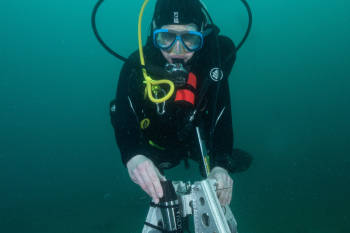© Pint of Science, 2025. All rights reserved.
When is grass a sign of climate trouble?
Dr Catriona Nguyen-Robertson was part of a large group of women and non-binary people working in STEMM who while travelling together, were taking turns using a pair of binoculars to catch a glimpse of grass growing on a land mass nearby. Peering through the binoculars, Dr Nguyen-Robertson’s expression suddenly shifted from that of a curious onlooker to a concerned scientist. She had just caught a glimpse of little tuffs of green jutting out between tight cervices. That can’t be bad, right? Except, she was in Antarctica.
Dr Nguyen-Robertson, a science communicator at The Royal Society of Victoria with a PhD in immunology, was on a tour of Antarctica when she saw first-hand the effects of climate change on its landscape. What she had just seen was Antarctic hair grass (Deschampsia Antarctica), which was rapidly claiming land owing to its increased rate of spread.
The grass here comes in two varieties: Deschampsia Antarctica and the Antarctic pearlwort (Colobanthus quitensis). Though native to the continent, these two species pose a threat to mosses and lichens that have grown on the continent for millennia. Despite being able to thrive in harsh conditions, the flora is not good at competing with each other and a rise in temperature might tilt the scales in the wrong direction.
The rise in temperature not only affects life above the surface of the sea but below it too. Sub-zero temperatures cause the water to freeze and form sea ice. This ice offers a habitat for algae that grow underneath and are a source of food for krill. With less ice and krill around, the penguins which feed on the krill slowly start to go hungry.

Image Credit: Dr Catriona Nguyen-Robertson
That’s not all the penguins have to worry about though. Antarctica might have a lot of snow and ice, but it is historically one of the driest places on Earth. During her visit, Dr Nguyen-Robertson encountered rain three times in a single day – a sign of climate change. This unexpected downpour is harmful to penguin chicks, whose are feathers are not waterproof, and so some might not survive owing to hypothermia.
The cracking of icebergs sounds like thunder and it’s not a pleasant experience hearing them all the time, recalls Dr Nguyen-Robertson. These icebergs chip off slowly, disintegrating into smaller segments, which will eventually melt into the sea, causing the water levels to rise. So, the next time you see wild grass growing somewhere unexpected, consider that there might be something more sinister going on!
We were lucky enough to have Dr Catriona Nguyen-Robertson share her insights in Antarctica at Pint of Science Australia 2025 in Melbourne. The ‘singing scientist ‘captivated the audience with stories and a short song based on the science of the southernmost continent.




